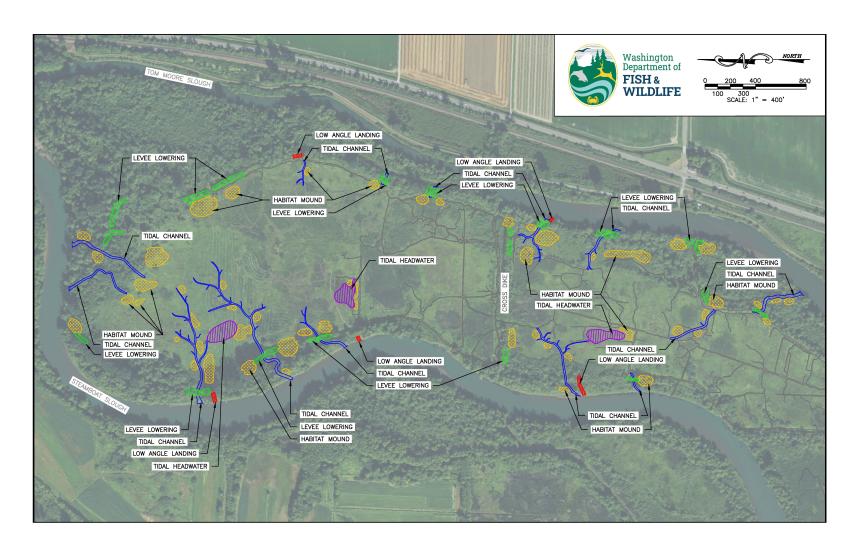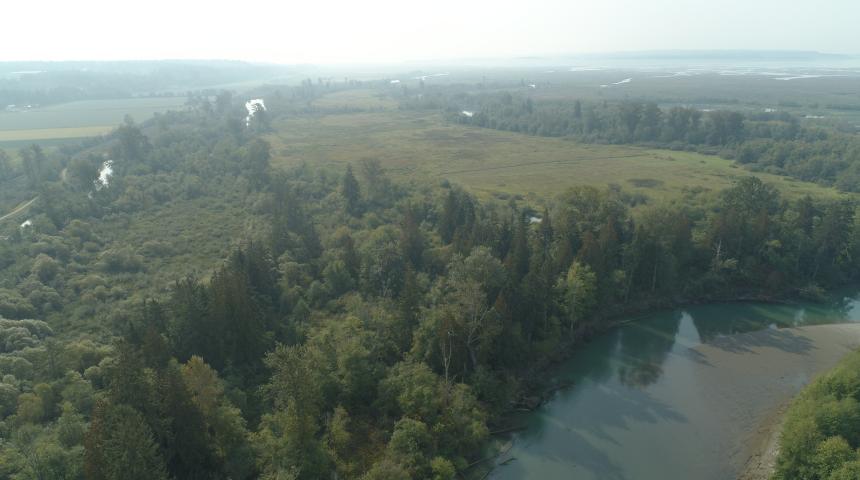- Feb. 14, 2025: Learn more about the completed Milltown Island Restoration Project in this WDFW blog post.
Read all project updates below.
The Milltown Island Estuary Restoration Project is located on a 220-acre site on a mid-channel island in the South Fork Skagit River. Most of the island was acquired by WDFW in 1951 and 1973 to create the Milltown Island Wildlife Area Unit.
Located where the river meets Puget Sound, the site is home to a rich mosaic of habitats for salmon, birds, beaver and other fish and wildlife. A restoration project completed in in 2024 built on previous restoration actions by constructing channels, shallow tidal headwaters and low planting mounds to create diverse habitats. Dikes were removed to restore tides and river flows to the site so that water and sediment continue to create and maintain habitat into the future. A map of the completed project is available here.
Milltown Island was once entirely tidal marsh. Early homesteaders diked and drained the island and they lived and farmed here for decades. But since flood-caused dike breaches and loss of a bridge to Milltown Island in the 1970s, the site has been left fallow. Between 1999 and 2014, additional dike breaches and channels were constructed for the benefit of salmon and other fish and wildlife that rely on estuaries.
Until summer of 2024 much of the dike system was still in place and the site remained largely cut off from full tidal exchange and river floods. Channels were not well-connected to the sloughs where juvenile salmon travel as they make their way from upriver spawning areas to Puget Sound, and vegetation was largely dense stands of non-native reed canary grass and cattail that are not good for fish or other species. To provide the maximum benefit possible, we removed dikes, created channels and low planting mounds, treated weeds and began planting native shrubs and trees.
Project benefits
The project benefits Chinook salmon by providing critical rearing habitat for juveniles as they migrate from freshwater habitats to the salty waters of Puget Sound. Juvenile Chinook that spend time in estuaries grow bigger and are better able to survive to adulthood. More Chinook, in turn, provide food for endangered Southern Resident orcas.
This project also benefits a variety of other fish, birds, and mammals. Habitat improvements benefit the more than 20 fish species that have been documented using neighboring estuary sites, including juvenile chum, coho and other salmon. Migratory waterfowl and shorebirds that use Skagit and Port Susan Bays also benefit. Project actions provide shallow water areas called tidal headwaters that are preferred by waterfowl and shorebirds, shrubs and trees for songbirds, and habitats for beaver and a variety of other wildlife.
Access to the site is only by boat. Channels built for salmon also provide improved recreational access into the site. Several low angle landings provide places for recreational visitors to more easily land a boat and walk onto the site.
Lastly, the project made the site more resilient to climate change impacts. The river carries a lot of sediment in this area. After construction, floodwater is able to spill onto the site through additional dike breaches and deposit the sediment it carries. This will cause the site to aggrade and potentially keep pace as sea level rises.

Click here for a larger version of this completed project map.
Project details
Partners involved
Technical and stakeholder input was an important part of the design process. A technical advisory committee consisting of experts in estuary science (salmon, geomorphology, vegetation), land management and restoration techniques guided an alternatives analysis that resulted in the 60% design. WDFW then reached out to local waterfowlers to get their input on design features that met estuary restoration needs and could also support waterfowl hunting on the site. Ducks Unlimited (DU) also reviewed the design and provided recommendations to meet the needs of waterfowl and hunters. Many of the waterfowler and DU recommendations were incorporated including:
- Addition and specific placement of multiple low angle landings along the main sloughs for improved recreational access.
- Addition of tidal headwaters, specific recommendations for mound placement, and support for weed management and establishment of native herbaceous vegetation for greater habitat diversity.
Milltown Island Restoration Project funders included
- WDFW and Washington Recreation and Conservation Office (RCO) Estuary and Salmon Restoration Program (ESRP)
- RCO Puget Sound Acquisition and Restoration Program
- U.S. Fish and Wildlife Service (USFWS) National Coastal Wetland Program
- NOAA Restoration Center Transformational Habitat Restoration and Coastal Resilience Grants under the Infrastructure Investment and Jobs Act
Project design
The construction phase of the project:
- Remove a portion of the perimeter dike and cross-dike (2,800 linear feet)
- Excavate new tidal channels and connections between existing channels and Tom Moore and Steamboat Slough (9.6 acres)
- Excavate tidal headwaters (1.5 acres)
- Create topographic relief through construction of low wetland mounds (3 acres)
- Construct low angle landings for boats and weed treatment equipment
- Remove farm debris (fencing and culverts)
Vegetation management is underway and will:
- Manage weeds through mowing and spraying
- Plant tidal headwaters with native herbaceous plants
- Plant native shrubs and trees
Contact
Contact information
For more information about the Milltown Island restoration project, please contact Jenny Baker at Jenny.Baker@dfw.wa.gov or 360-855-8325.
Updates
- Feb. 14, 2025: Learn more about the completed Milltown Island Restoration Project in this WDFW blog post.
- Oct. 7, 2024: The Milltown Island Unit has reopened to the public following completion of the estuary habitat restoration project in early October 2024.
During summer 2024, an estuary restoration project was completed on this area, including extensive excavation of new channels and low areas, lowering of remnant dikes, construction of mounds, and the movement of equipment across the site. Some of this activity has resulted in softened soil, equipment ruts, and other hazards that did not previously exist. Visitors should exercise extreme caution, especially during high water conditions which may obscure potentially hazardous areas.
